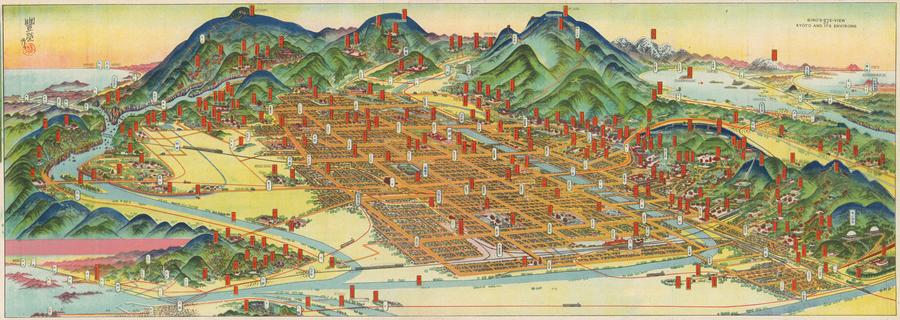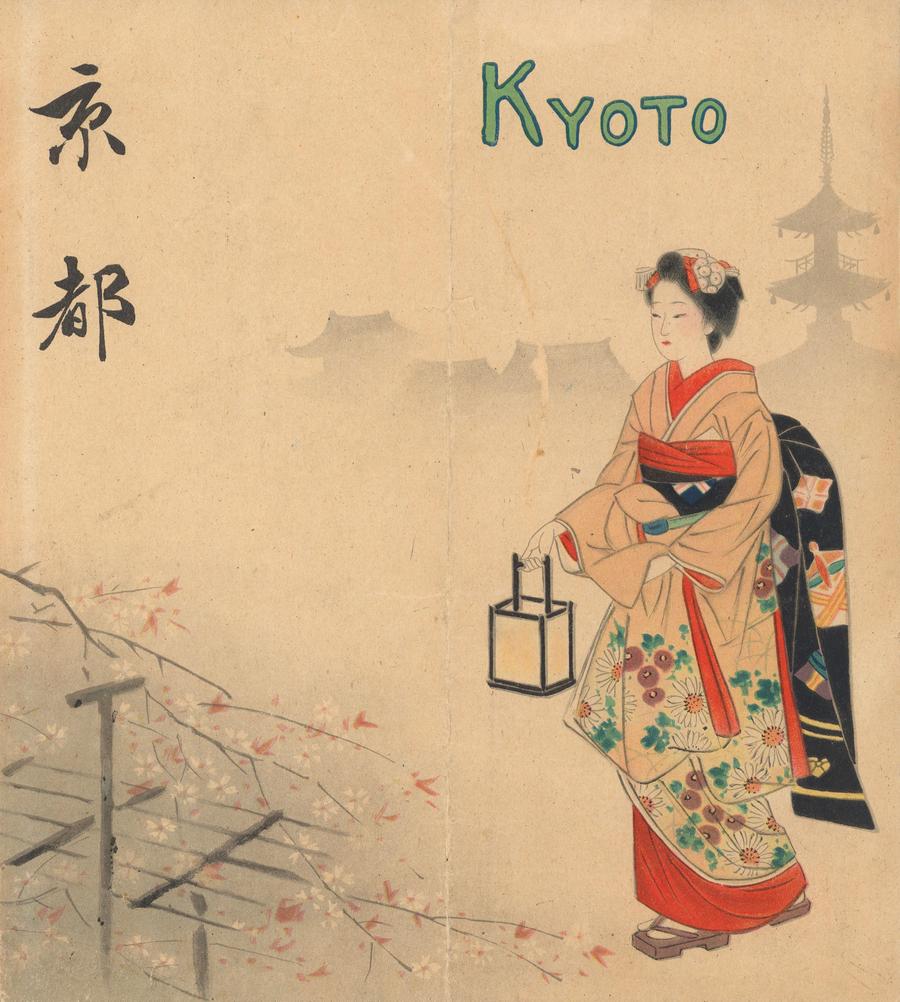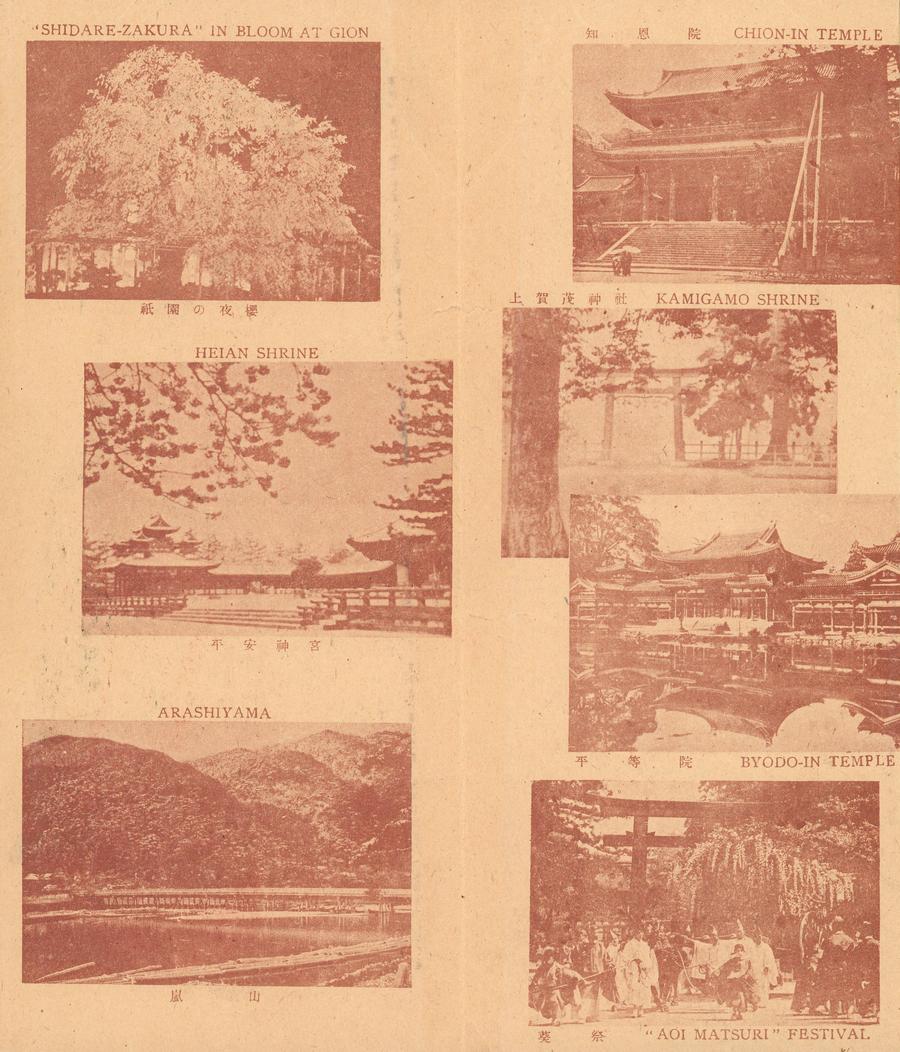|
|
Хацусабуро Ёсида. Карта Киото с высоты птичьего полета. 1947
Hatsusaburo Yoshida. Bird's-eye-view Kyoto and its environs. 1947. Click to open a high-resolution image
Карта Киото с высоты птичьего полета, размером 26,5×76 см (в сложенном виде — 26,5×12 см). На карте показаны здания, деревья, парки, достопримечательности, улицы, железные дороги, реки и т. д. Название и текст, туристическая информация на английском и японском языках, названия мест на японском языке. Рельеф показан в виде рисунка. Предположительная датировка.
С 794 по 1869 год Киото был столицей Японии, главной резиденцией Императоров.
Note:
Bird's-eye view, pictorial map of Kyoto, 26.5x76, folded into heavy paper covers, 26.5x12. Map showing buildings, trees, parks, landmarks, roads, railroads, rivers, etc. Title and text, tourist information in English and Japanese and place names in Japanese. Relief shown pictorially. Date estimated.
Автор карты — Хацусабуро Ёсида (吉田 初三郎, Yoshida Hatsusaburō, 1884—1955) — японский картограф и художник, широко известный своими картами городов и поселков с высоты птичьего полета. Называемый «Хиросигэ эпохи Тайсё», Ёсида за свою жизнь создал более 3000 карт.
В 1914 году его первая карта «Путеводитель по поезду Кэйхан» с видом с высоты птичьего полета была высоко оценена императором Шова (тогда наследным принцем), который находился на борту поезда Кэйхан во время учебной поездки.
Популярность карт Хацусабуро возросла в связи с туристическим бумом в Японии в эпоху Тайсё и Шова. Ёсида основал компанию Taishō meisho zue-sha (компания по иллюстрированию знаменитых мест Тайсё), которая позже была переименована в Kankō-sha (туристическая компания). Ёсида посещал места, которые он изображал на картах, беседовал с людьми и изучал популярные достопримечательности.
В 1921 году, в честь 50-летия железнодорожного транспорта в Японии, Министерство железных дорог решило издать справочники «Информация о железнодорожных путешествиях» с картами, проиллюстрированными Ёсидой. Он также создал плакаты для кампании Международного бюро туризма «Прекрасная Япония» в 1930-х годах.
В течение этого десятилетия Ёсида был завален просьбами создать карты всей страны (включая Маньчжурию и Тайвань) с высоты птичьего полета. Он нанял учеников для помощи в работе, а свою базу переместил в города Инуяма и Хачинохе (побережье Танэсаси). Он также получал просьбы от многих друзей, таких как члены королевской семьи, например, принц Такамацу, и солдаты, например, Иване Мацуи. Однако во время Второй мировой войны выпуск карт Ёсида замедлился; военные посчитали, что карты могут выдать врагу военные секреты, например, тайные гавани.
Первой крупной работой Ёсиды после войны стала карта последствий атомной бомбардировки Хиросимы.
Текстовая часть издания на английском:
KYOTOGENERAL
Kyoto, known in antiquity by the name of “Heian” (the city of peace), was for about a thousand years the metropolis of Japan, until at the Restoration in 1868 A. D. (“Meiji Ishin”) the Emperor Meiji moved his capital to Tokyo (the eastern capital). Although, since the foundation terrible battles and fires had sometimes reduced the whole city to ashes, Toyotomi-Hideyoshi and others reconstructed it and restored the destroyed temples and shrines, and fortunately exempt from air-raids of the World War II, Kyoto can hold on its glory and splender of the historical associations, as well as the beautiful natural scenes of swift-running rivers and surrounding hills and mountains.
Thus with so many temples and shrines, Kyoto is looked upon as the classic city and the cultural leader in the western part of the country, in contrast with the industrial Osaka. Beside some modern industries various fine art manufactories are engaged in here and their hand-made products are renowned as lacquer, silk embroidery, brocades, kimonos, cloisonne, bronzes, porcelains, fans, dolls, bamboo wares, etc. (though some of them are stopped in the war-time.)
Kyoto and its vicinity are the center of a vast recreation region and have countless spots of interest, of which Higashiyama District with the Maruyama Park, Mt. Hiei, the Lake Biwa, Hozu Rapids (Arashiyama) and Uji are the favorite haunts of sightseers and pilgrims, specially in virtue of cherry-blossoms in spring and brilliant tints in autumn.
Nara, the capital antecedent to Kyoto, lies in the south of the city and is the similar classic city with the world-famous Deer Park, a great bronze Buddha, Kasuga Shrine, etc.
TRANSPORTATION
Government Railroad: The Tokaido line from Tokyo via Otsu on the Lake Biwa, detaching here (1) the San-in line via Saga (Arashiyama) to the northwestern part of the country, and (2) the Nara line via Momoyama and Uji to Nara, runs westward to Osaka and Kobe.
Municipal Street-car (fare: 10 sen a time).
Suburban Electric Railroads : On the north the Eizan el. line starts from Demachi-Yanagi and goes to Yase, Mt. Hiei (cable-way is stopped the time being) and Kurama.
On the northwest the Arashiyama el. line extends from Shijo-Omiya to Arashiyama and connects with the Atago el. line.
On the south Kyoto is connected with Osaka by two electric lines, the Shin(new)-Keihan line from Shijo-Omiya (Keihan-Kyoto) with a branch to Arashiyama, and the Keihan line from Sanjo via Inari and Momoyama with a branch to Uji. Nara may be also visited by the Nara el. line departing from the Kyoto Station of the Government Railroad.
On the east Keihan el. line extends from Sanjo to the city of Otsu, from which terminal Port-Otsu we may have the round trip of the Lake Biwa by excursion vessels.
TOURIST BUREAU AND GUIDE OFFICES
1. Japan Travel Bureau: in the Kyoto Station, Daimaru and Marubutsu Dept. Stores, Miyako and Kyoto Hotels.
2. Municipal Guide Office: in front of the Kyoto Station.
3. Suburban El. Railroads give their guides at all the terminals in the city.
SOUVENIRS
Kimonos (Nishijin-Ori etc.), Lacquers, Fans, Dolls, Porcelains, Tools of Buddhism, Papers (Post cards, envelopes, etc.) with woodcut, Bamboo wares, etc.
NOTICE
Every spot in the city is named by its wot right-crossing streets, e. g. Shijo-Kawaramachi, Shijo-Omiya.
Store of English books: Maruzen, a little northward from Shijo-Kawaramachi.
Shopping streets, especially for souvenirs: Shijo-, Kawaramachi-, and Sanjo-Streets, Shin-kyogoku, etc.
A – PALACES
KYOTO IMPERIAL PALACE, the home of the Imperial Family down to the Restoration of 1868 A. D., is situated in the northern part of the city, and now used only at the time of the Coronation. The park outside it is open to the public.
KATSURA AND SHUGAKUIN DETACHED PALACES are celebrated for their excellent gardens and rare works of old Japan architectures, especially the former has become world-famous since the praise by Bruno Taut.
B – PLACES OF INTERESTIN THE NORTHERN AND EASTERN PART OF THE CITY
SHIMOGAMO and KAMIGAMO SHRINES stand cinnabar colored in the serene woods, and are noted for their chief festival “Aoi-Matsuri” (Hollyhock Festival) held on May 15, the origin being traced back to the 6th century. It is a court festival conducted in purest Shinto style.
MT. DAIMONJI, at the north end of the Higashiyama Mountains, is named for its fire-illumination letter “Dai” lighted by many torches on the hillside on August 16.
Of the surrounding well-wooded mountains HIGASHIYAMA are the most beautiful and at the foot of them arrayed many shrines and temples, i. e.:
GINKAKUJI or Silver Pavillion, modeled on the Kinkakuji or Gold Pavillion (as mentioned later), was built by Shogun Ashikaga-Yoshimasa in 1479 A. D. as the place of retirement. Its landscape garden is one of the best in Japan.
HEIAN SHRINE, near the Okazaki Park, a replica of a part of the first Imperial Palace, is noted for its buildings and attractive garden. “Jidai Matsuri” (historical pageant, a procession in medieval costumes) is one of the interesting festival of Kyoto, held on October 22.
NANZENJI, one of the five head temples of the Zenshu Sect, with its celebrated garden, and EIKANDO, are located among the pine trees and maples.
CHION-IN, the head temple of the Jodo Sect, is noted for its grand buildings and “Uguisubari” (nightingale-) corridor chirping as stepped on.
MARUYAMA PARK, Kyoto’s principal park, is celebrated for its ’’Shidare Zakura”, or willowy cherry tree, over 400 years old, which when in bloom is illuminated by torches and colored lights.
YASAKA SHRINE, in the Maruyama Park. Its festival ”Gion Matsuri” held on July 17, is admired as one of the most spectacular festivals of Japan for its decorated procession of many “Hokos”.
KIYOMIZU TEMPLE, commands a fine view of the city and adjacent country. Its approach is lined with crockery shops, known to foreigners as “Tea-pot Lane”. The cherry blossoms and the maple tints below the grand balcony give us a splendid and attractive sight.
MUNICIPAL MUSEUM, originally erected by the Imperial Household and donated later to the municipality, exhibits valuable works of classic fine art.
SANJUSANGEN-DO, or 33 Ken Hall, so called because the spaces between the front pillars of the temple measure 33 (Sanjusan), is celebrated for its 1,001 images of the Goddes Kwannon, each with 1,000 hands or eleven faces.
IN THE SOUTHERN PART OF THE CITY
NISHI-HONGANJI, headquarter of the influential Shinshu Sect, and HIGASHI-HONGANJI, of another branch of the same Sect. The buildings and garden of the former are quite old (about 13th century), while the latter built in Meiji Era is known as one of the grandest wooden structures in the world.
IN THE NORTH-WESTERN PART OF THE CITY
NIJO CASTLE, formerly the Imperial Detached Palace, is now open to the visitors, after donated to the municipality. It was erected in 1569 and thereafter the abode of the Tokugawa Shoguns when staying in Kyoto. Its interior is elaborately decorated in the Momoyama style (of the 16th century).
KINKAKUJI or Gold Pavillion, built in 1397 A. D. by the Ashikaga Shogun Yoshimitsu, is so called because its interior was once entirely covered with gold foil. On its upper story part of the foil still gives evidence of its past glory. The garden is celebrated for its natural beauty.
MYOSHINJI and NINNAJI, respectively head temples of the two Buddhism Sects. The latter is famous for the double-flowered cherry trees within the precinct.
KITANO SHRINE (Temmangu) is dedicated to an ancient patriot Sugawara-Michizane. The building represents a pattern of old shrine architecture.
ARASHIYAMA, with the River Oi running down from Kameoka to here in HOZU RAPIDS, makes up one of the finest resorts of the city. In its vicinity lie TENRYUJI, one of the five head temples of the Zenshu Sect, DAIKAKUJI and other historical associations in harmony with the natural scenery.
OUT-OF-TOWN TRIPS
LAKE BIWA is the largest fresh-water lake in Japan. Excursion vessels sail from Port Otsu (Hama-Otsu) around the lake and to Chikubushima Islet everyday, while another liners visit the “Eight Sights” and Biwako Hotel on the lake shore in its southern part.
MT. HIYEI, 2799 ft. Take electric car from Demachi-Yanagi to Yase, thence cable railroad (stopped now) up to the peak. From its summit there are wide view of over Kyoto and the Lake Biwa. Eizan Hotel is available near the terminal of the cable-way. Alter visiting Enryakuji Temple the decent may be made by another cable line to Sakamoto on the Lake, and return to Kyoto by electric car via Otsu.
TAKAO, MAKINO-O and TOGANC-O, lie close together along the ravine at the foot of Mt. Atago, 3030 ft., on the outskirts of Kyoto. They constitute the historic places with temples, over which is spread the glory of maples in autumn.
UJI, where grows the choicest green tea, is a popular spot for excursion from Kyoto by electric or motor car. The Phoenix Hall of BYODO-IN Temple built in 11th century stands on the River Uji as a sample of the best religion architecture of the period when the Fujiwara Family was in its glory.
6 мая 2023, 23:42
0 комментариев
|
Партнёры
|











Комментарии
Добавить комментарий